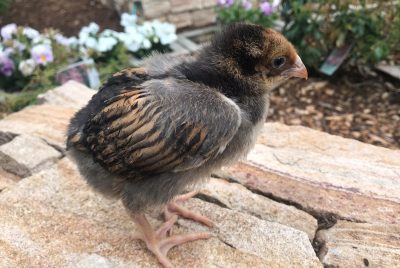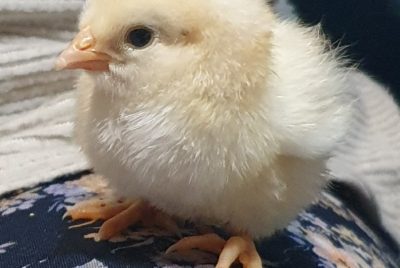How to Choose the Best Heat Source for Baby Chicks!
You want to make sure your baby chicks are kept warm and comfortable, but with so many heat source options out there, it can be overwhelming. In this guide, I’ll share with you the most important factors to consider when choosing a heat source to keep baby chicks warm. From heat lamps to heating pads, I’ll discuss the pros and cons of each option so you can make the best decision for your newest feathered friends. Let’s keep those chicks cozy and happy!
Key Takeaways:
- Consider the Needs of the Chicks: The age of the chicks, the number of chicks, and the climate of your area can all influence the heat source you choose.
- Choose a Safe and Reliable Heat Source: Ensure that the heat source is safe, reliable, and specifically designed for use with baby chicks to prevent accidents and injuries.
- Provide Adjustable Heat: Opt for a heat source that allows you to adjust the temperature to meet the changing needs of the growing chicks.
- Monitor Temperature Regularly: Use a thermometer to monitor the temperature in the brooder and make adjustments as needed to keep the chicks comfortable and healthy.
- Consider Energy Efficiency: Choose a heat source that is energy efficient to help reduce electricity costs while still providing adequate warmth for the chicks.
6 Crucial Tips on How to Take Care of Your Baby Chicks.
Raising Baby Chicks on a Budget – Essential Tips You Can’t Miss!
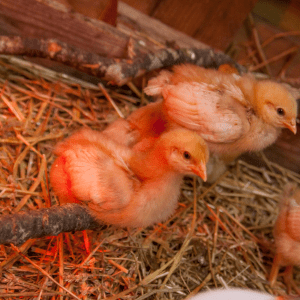
Importance of Heat for Baby Chicks
Why Baby Chicks Need Heat
Before we probe the various heat sources for baby chicks, let’s understand why providing the right amount of heat is crucial for their well-being. Baby chicks are unable to regulate their body temperature effectively, and without a supplemental heat source, they can quickly become chilled, leading to a host of health problems. Proper heat is important for their growth, development, and survival during the crucial early days of their life.
Consequences of Inadequate Heat
On any farm or homestead, ensuring your baby chicks have adequate heat is paramount. If chicks are exposed to temperatures that are too low, they can suffer from chilling, dehydration, and even death. Chilled chicks may become lethargic, have decreased appetites, and are more susceptible to diseases.
Heat lamps, heat plates, or infrared bulbs can be used to provide the necessary warmth for your chicks, keeping them cozy and helping them thrive during their early stages of life.
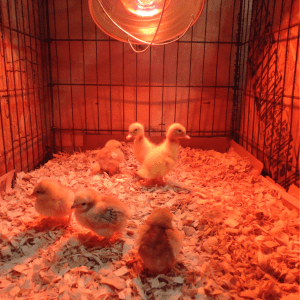
How to Keep baby chicks warm – Types of Heat Sources
One of the most critical factors in raising baby chicks is providing them with adequate warmth. There are several types of heat sources you can choose from to keep your chicks cozy and healthy. Here are some popular options to consider:
| Brooder Lamps | Ceramic Heat Emitters |
| Heat Mats | Infrared Heat Lamps |
Brooder Lamps
For brooder lamps, you will need to hang the heat lamp securely above the brooder area to provide warmth to the chicks. It is vital to keep a close eye on the temperature to ensure it is neither too hot nor too cold for the chicks. Make sure to use a red heat bulb to reduce stress on the chicks.
Adjust the lamp height as the chicks grow to maintain the optimal temperature. Start with around 95 degrees Fahrenheit for the first week, then decrease by 5 degrees each week until the chicks are fully feathered.
Ceramic Heat Emitters
An advantage of ceramic heat emitters is that they produce heat without emitting light, which can help reduce stress on the chicks. They are durable and long-lasting, making them a popular choice among poultry owners.
Heat emitted by ceramic heat emitters is consistent and helps mimic natural sunlight to promote healthy growth and development in baby chicks. These heat sources are typically attached to a ceramic socket and can be easily installed in your brooder setup.
Heat Mats
Heat mats are placed beneath the brooder area to provide consistent warmth to the chicks. They are energy-efficient and can help maintain a steady temperature in the brooder. It is important to monitor the temperature regularly to ensure the chicks are comfortable.
Place a flat board or insulation layer between the heat mat and the brooder floor to ensure optimal heat distribution. This setup prevents hot spots and evenly warms the chicks.
Infrared Heat Lamps
Heat lamps are a popular choice for providing warmth to baby chicks. They emit infrared heat, which is gentle on the chicks and helps maintain a consistent temperature in the brooder. It is vital to position the heat lamp at the right height to prevent the chicks from getting too hot or too cold.
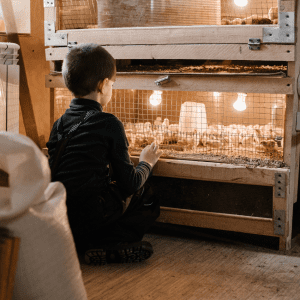
Factors to Consider When Choosing a Heat Source
Keep a few important factors in mind when selecting the best heat source for your baby chicks. Chick age and size, brooder size and insulation, ambient temperature, and humidity levels all play a critical role in keeping your baby chicks warm and healthy. Recognizing these factors will help you provide the ideal environment for your feathered friends.
Chick Age and Size
The age and size of your chicks will determine the amount of heat they need. Younger chicks and smaller breeds require more warmth compared to older chicks or larger breeds. It’s necessary to provide a heat source that can be adjusted to cater to the specific needs of your chicks as they grow. Maintaining the right temperature is crucial for their growth and well-being.
Brooder Size and Insulation
The size of your brooder and its insulation also impact the efficiency of the heat source. A smaller brooder may require a more concentrated heat source, while a larger brooder would need a heat source with a wider range. Proper insulation helps retain heat and ensures a consistent temperature throughout the brooder, creating a comfortable environment for your baby chicks.
Factors such as the material of the brooder and any drafts in the area can affect how well the heat is retained. Inspecting and optimizing these factors will help you choose the most suitable heat source for your chicks.
Ambient Temperature
| Size | Temperature |
| Too Cold | Below 70°F |
| Too Hot | Above 95°F |
Ensuring the ambient temperature around the brooder is just as important as providing an internal heat source. Baby chicks are sensitive to extreme temperatures, so it’s crucial to monitor the surroundings to prevent them from getting too cold or too hot. Adjusting the heat source according to the ambient temperature will help maintain a comfortable and safe environment for your chicks.
This temperature table serves as a guideline for maintaining optimal conditions for your baby chicks. Be vigilant in monitoring the temperature to keep your chicks healthy and thriving.
Humidity Levels
Chick humidity levels can influence how effectively a heat source warms them. High humidity can make chicks feel colder and increase the need for heat, while low humidity can dry out their respiratory tract. It’s important to strike a balance and provide adequate moisture in the air to keep your chicks comfortable and healthy.
This humidity information sheds light on another crucial aspect to consider when choosing a heat source for your baby chicks. Maintaining the right humidity levels will contribute to a cozy and nurturing environment for your feathered companions.

Safety Precautions
Fire Hazards
Precautions: After choosing a heat source for your baby chicks, it’s important to take precautions to avoid fire hazards. Always ensure that the heat source is securely mounted and stable to prevent accidental tipping over. Keep the heat source away from any flammable materials, such as bedding, and check regularly for any signs of wear or damage.
Electrical Safety
Fire: When using heat lamps or other electrical heat sources for your baby chicks, it’s crucial to prioritize electrical safety. Make sure to use a properly rated extension cord if needed and avoid overloading electrical outlets. Additionally, regularly inspect cords and plugs for any fraying or exposed wires that could pose a fire hazard.
The proper installation and maintenance of electrical heat sources are necessary for the safety of your baby chicks. Always follow manufacturer guidelines for usage and never leave heat sources unattended.
Chick Safety
Any: The safety of your baby chicks is paramount when using a heat source. Avoid using heat sources that emit harmful fumes or gases, as chicks are particularly sensitive to these. Ensure that the heat source is providing a consistent and appropriate level of warmth for the chicks’ age. Overheating or getting cold can be harmful and sometimes they can’t heat up and they die.
Chick safety should always be the top priority when choosing and using a heat source for your baby chicks. By taking the necessary safety precautions, you can create a warm and cozy environment for your chicks to thrive in.

Heat Source Maintenance and Cleaning
Regular Cleaning Schedule
Source: It’s crucial to have a regular cleaning schedule for your heat source. This ensure’s the health and safety of your baby chicks. I recommend cleaning the heat source at least once a week. This will help prevent any dust or debris from accumulating and potentially causing a fire hazard.
Replacing Heat Lamps
Schedule: I suggest replacing heat lamps every season or after approximately 2,000 hours of use. This will ensure that the heat source remains efficient and effective for your baby chicks. Additionally, regularly inspect the heat lamps for any signs of wear or damage.
Lamps: When replacing heat lamps, be sure to choose the correct wattage and type for your brooder setup. **Using the wrong heat lamp can result in overheating or underheating**, both of which can be dangerous for your baby chicks.
Monitoring Temperature
| To | Ensure Proper Temperature: |
| 1. Use a thermometer to check the temperature regularly. | 1. A temperature that is too high can harm your chicks, while a temperature that is too low can lead to illness. |
| 2. Adjust the height of the heat source to regulate the temperature. | 2. **Maintaining a consistent and appropriate temperature is crucial for the health and well-being of your chicks.** |
Monitoring: It’s important to **regularly monitor the temperature in your brooder**. This ensures it stays within the optimal range for your baby chicks. Making adjustments to the height of the heat source can help regulate the temperature and create a comfortable environment for your chicks to thrive.

Troubleshooting Common Issues
Chicks Too Hot or Cold
All baby chicks need to be in a comfortable environment to thrive. The temperature should be carefully monitored to ensure that they are not too hot or too cold. If your chicks are huddled together under the heat source, they might be too cold. On the other hand, if they are staying far away from the heat source and panting, they might be too hot. Adjust the height or temperature of the heat source accordingly to create a more comfortable environment for your chicks.
Heat Source Malfunction
The last thing you want is for your heat source to malfunction when raising baby chicks. To prevent this, always double-check the heat source regularly to ensure it is working properly. Make sure to have a backup heat source or a plan in place in case the primary one fails. Additionally, be mindful of any frayed cords or potential fire hazards to keep your chicks safe and warm.
Plus, when using a heat lamp, always make sure it is securely positioned. You do not want any risk of falling or coming into direct contact with flammable materials. Constantly supervise the heat source to prevent any accidents that could harm your baby chicks.
Chick Health Problems
Issues such as pasty butt, respiratory infections, or splay-legged chicks can arise if the temperature is not properly regulated or if the environment is not kept clean. It is crucial to monitor your chicks daily for any signs of distress or illness. Provide them with a clean living space, fresh food, and water to promote their health and well-being.
For instance, pasty butt can be a serious condition in baby chicks where their droppings stick to their vents. This can block them from excreting waste. If left untreated, it can be fatal. Therefore, it is necessary to check your chicks regularly and clean any build-up to ensure their vents are clear and they can eliminate waste properly.
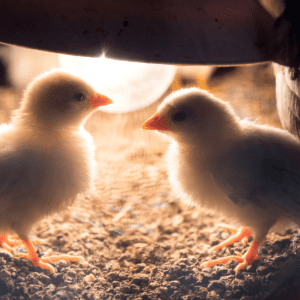
Final Words on How to Keep Baby Chicks Warm
So, when it comes to choosing the best heat source for your baby chicks, it is crucial to consider their safety and comfort. As I mentioned earlier, always opt for a heat lamp with a red bulb to reduce stress and ensure a more natural sleeping pattern for the chicks. Remember to position the heat source at the right height and efficiently monitor the temperature to avoid any overheating incidents.
FAQ’s about How to Keep Baby Chicks Warm
Q: Why is it important to choose the right heat source for baby chicks?
A: It is important to choose the right heat source for baby chicks to provide them with a safe and comfortable environment for optimal growth and development.
Q: What types of heat sources are suitable for baby chicks?
A: Suitable heat sources for baby chicks include brooder lamps, heating plates, and infrared bulbs. Each type has its pros and cons, so it’s important to choose the one that best meets your needs.
Q: How do I determine the appropriate heat source for my baby chicks?
A: To determine the appropriate heat source for your baby chicks, consider factors such as the number of chicks, the size of the brooder area, and the ambient temperature of the room. Consult with your local agricultural extension office or a poultry expert for personalized advice.
Q: What temperature should the brooder be for baby chicks?
A: Keep the brooder temperature for baby chicks at around 95 degrees Fahrenheit during their first week. Then, gradually decrease it by 5 degrees each week until they are fully feathered and can regulate their own body temperature.
Q: How can I ensure the safety of my baby chicks with the chosen heat source?
A: To ensure the safety of your baby chicks with the chosen heat source, make sure to regularly check the temperature in the brooder. Keep the heat source clean and secure, and monitor the chicks for signs of overheating or chilling. Additionally, always follow the manufacturer’s instructions for the heat source you choose.
Mastering Pasty Butt Cleaning – Keep You CHicks Healthy and Happy
Unlock Secrets to Raising Chicks Like a Pro
Ready to Sell – Find Out the Perfect Time To Sell Your Chicks
Prevent Pasty Butt – Top Tips for Keeping Your Chicks Clean.


